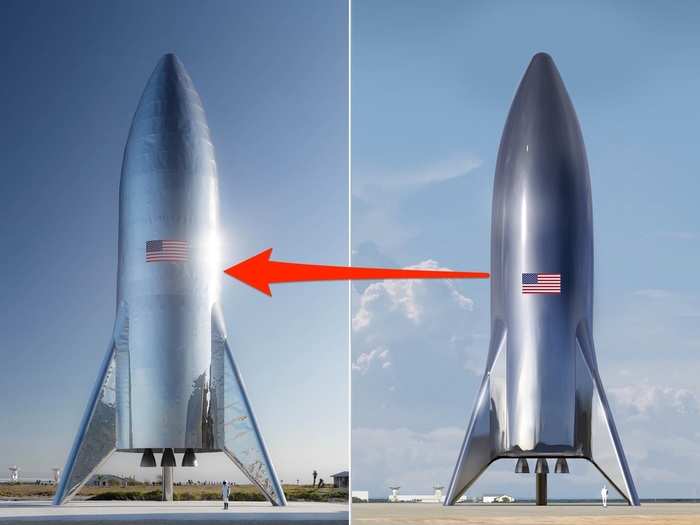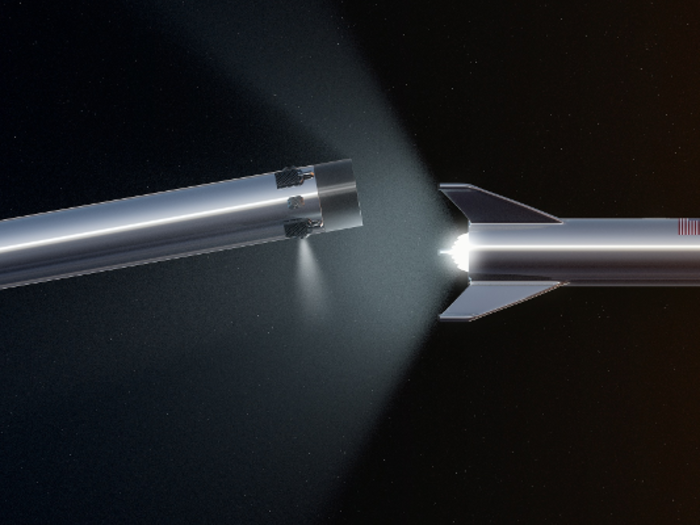- Home
- slideshows
- miscellaneous
- Elon Musk just revealed 5 major updates to SpaceX's Mars spaceship project. Here's what we learned.
Elon Musk just revealed 5 major updates to SpaceX's Mars spaceship project. Here's what we learned.
The first hops of the Test Hopper may indeed happen this week.

SpaceX ditched the Test Hopper's damaged nosecone.

Activity at SpaceX's Boca Chica site began to boom in November. Residents in the area said crews were working almost 24/7 to weld together a structure that at first appeared to be a water tower. Later, it became apparent that they were building a rocket ship: the Test Hopper.
Musk confirmed the vehicle's construction in December. A few weeks later, he shared a rendering of what it'd look like, followed by a photo showing that SpaceX had completed construction on the outer hull.
But soon after, gale-force winds in Texas blew the nosecone over and damaged it. Musk initially said it'd take a few weeks to repair, but he revealed on Sunday that the nosecone is now in the scrap pile.
"We decided to skip building a new nosecone for Hopper. Don't need it," Musk tweeted.
A full-scale Starship is under construction.

In his recent tweets, Musk also addressed photos of another vehicle currently under construction at SpaceX's facility in Boca Chica, Texas.
"What you see being built is the orbital Starship vehicle," he said.
Musk previously suggested that SpaceX would finish building a taller, orbit-capable Starship prototype "around June." That rocket ship would have "thicker skins (won't wrinkle) & a smoothly curving nose section" compared to the Test Hopper, he added.
On Sunday, Musk said that the orbit-capable Starship would be "full size," though he didn't say whether he was referring to the roughly 180-foot-tall Starship spaceship, or to both the spaceship and its 220-foot-tall Super Heavy booster. (The booster is the part of the system that would help heave a Starship into orbit and conserve its fuel supply.)
If SpaceX builds both parts concurrently, a mirror-polished rocket ship the size of a 40-story building may appear in south Texas this summer.
Starship's heat shield has changed radically — again.

On Sunday, Musk shared a video (above) of heat-shield tiles passing a "full duration" test.
These tiles are the most recent iteration of the technology SpaceX is developing to cool and protect Starship as it re-enters Earth's atmosphere and attempts to land. Such protection is necessary because spacecraft plow through Earth's atmosphere at roughly 25 times the speed of sound when they return, creating scorching-hot plasma that can vaporize steel.
Previously, Musk had said that Starship's heat shield would "bleed" rocket fuel from tiny pores in the spaceship's skin, thereby cooling it down. But a full "bleeding" system would have faced a number of unprecedented challenges, since clogged pores could lead to the destruction of Starship.
Musk's new video suggests that SpaceX has decided to go with a combination of hexagonal tiles and sections of Starship that'd transpire fuel.
"Hexagonal tiles on most of windward side, no shield needed on leeward [back] side, transpiration cooling on hotspots," Musk said, later adding: "Transpiration cooling will be added wherever we see erosion of the shield. Starship needs to be ready to fly again immediately after landing. Zero refurbishment."
In effect, Musk was hinting at SpaceX's iterative test plan for Starship: Build one with a tile-based heat shield, get it into orbit, land it, then examine the tiles for wear. In the spots where tiles look especially battered by 2,000-degree-Fahrenheit plasma heating, engineers will try to implement the "bleeding" cooling system.
Musk wants to launch Starships in Florida, too.

SpaceX has not yet been clear about where, exactly, the company plans to build the Starship vehicles.
In April, LA mayor Eric Garcetti approved the company's plan to build Mars vehicles at the Port of Los Angeles. But that plan was made when SpaceX was attempting to manufacture large carbon-fiber structures. So there's now doubt about whether and how SpaceX might use the LA site going forward.
That uncertainty increased on Sunday, when a Twitter user asked Musk where Starship's first orbital flights would occur.
"Working on regulatory approval for both Boca Chica, Texas, and Cape Kennedy, Florida," Musk said. "Will also be building Starship & Super Heavy simultaneously in both locations."
Transporting sections of a roughly 30-foot-wide, 400-foot-tall vehicle from LA to launch sites in Texas or Florida would not be cheap or easy.
Popular Right Now
Popular Keywords
Advertisement